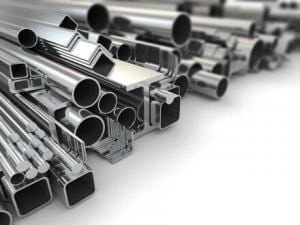PosiBlog
Stainless Steel, the Archangel Metal
By John Gentry, CEO of Positronic
Nearly everyone has heard of stainless steel and used it in some way, shape or form. But few know what it is, how it’s made, or why it’s preferred in so many applications. At Positronic, we consider it the miracle metal, perfectly suited for connector needs in harsh environments.
Unlike iron, which has been used for thousands of years, stainless steel is a relative newcomer, first produced only about 100 years ago.
You’ll find the metal in almost every manufacturing sector, from healthcare and catering equipment, to automotive and national defense, outperforming copper, aluminum, carbon steel, and even cadmium.
The secret to its success? A set of incredible physical and chemical properties. Stainless steel offers high corrosion and heat resistance, up to 1200°C/2192°F. It’s formable, weldable, and durable. It doesn’t rust. It doesn’t react to many substances. And compared to other specialized, non-corrosive alloys, it’s inexpensive. Let’s take a closer look.
Invention of Stainless Steel
Harry Brearley of Sheffield, England, is widely credited with discovering ‘rustless’ steel. Head researcher at Brown Firth Laboratories, Brearley was asked in 1912 to help a small arms manufacturer prolong the life of their gun barrels, which kept eroding too quickly. Brearley set out to create an erosion-resistant steel, and began experimenting with varying levels of chromium and carbon.
In August of 1913, Brearley created a steel with 12.8 percent chromium and 0.24 percent carbon, argued to be the first ever stainless steel. He etched his new creation with nitric acid and examined it under a microscope to check resistance to chemical attack. What he saw was promising, and he went on to test with other agents, including lemon juice and vinegar. Brearley was astounded to find that his alloys were still highly resistant, and recognized the potential for his ‘rustless’ steel. Over the next few decades, further improvements were made by various contributors, giving us the stainless steel we know today.
Some forty years ago, when I first started in this field, the metal was widely recognized in English as CRES, or corrosion resistant steel. Built into the name was its primary quality: corrosion resistance.
Miraculous Abilities
One of the most amazing qualities of stainless steel is its ability to heal itself. Like some superhero from a comic book, (Marvel’s Archangel, anyone?), it can actually “regenerate” after sustaining physical or chemical wounds. The alloy’s chromium content forms an invisible film on its surface. When exposed to oxygen, the film heals over any compromised areas.
It’s that invisible layer of protection that also makes it an ideal choice for hospital and other hygiene-sensitive applications.
Uses and Applications
Stainless steel has found a myriad of applications from the tiniest structural parts in artificial heart valves to the largest architectural structures. Several world-famous monuments, such as the Cloud Gate sculpture in Chicago (otherwise known as “The Bean”), have been constructed using stainless steel.
One way to differentiate alloy quality is magnetism. The highest quality stainless steel is not magnetic (although with an enormously powerful magnet, almost anything with the slightest iron content will be attracted. For alloys, the notion of non-magnetism is not absolute).
There are different nomenclatures for stainless steel. A hardware store may advertise their stainless steel as 18/8: 18 percent chromium and 8 percent nickel. That indicates high quality.
Stainless Steel at Positronic
In the world of high performance electronic connectors, we use a variety of stainless steels. Much of it is in the premium 300 series – common alloys like 302, 304 and 305. They’re all high quality, with only slightly different characteristics. The 304 alloy is the most widely used stainless steel in the world. You can find it in everything from cars and knives to the space shuttle. It’s also known as food grade. It’s weldable, machinable, and has high resistance to corrosive chemicals and harsh atmospheres.
Positronic parts made of stainless steel still need further processing. We call it the passivation process, making the surface passive and non-reactive. When you’re fabricating something out of stainless steel, you have to recognize that it has pores. Iron particles can find their way into the pores, introducing rust and corrosion. The passivation chemical wash clears everything out, ensuring maximum corrosion resistance.
Our customers have a lot of military and defense applications, and in many of these cases, they understand that the highest quality stainless steel is superior to cadmium-plated solutions.
We see stainless steel as superior to cadmium for many applications, and the good news is that the price is now on par. There used to be a big differential, but we’ve seen improvements in both stainless quality and pricing over the last 15 years.
We’re not the only manufacturer making stainless steel connectors, but we do offer the greatest variety of stainless solutions in the industry. D-series connectors are produced by hundreds of companies. But Positronic is one of only a few companies that use stainless steel in their D-subs.
At Positronic, we’re the sole source for many connectors using stainless steel. True, we also supply cadmium for certain military applications and tough environments. But we love stainless steel – the metal that does not corrode, the Archangel alloy that heals itself under fire. Its qualities are nearly miraculous, and its cost is comparable to would-be competitors. You might say stainless steel is the shining hero of the Positronic catalog.
Latest Posts
- Milexia and Neumueller Named as Exclusive Value-Add Distributor Partners for UVAC Hermetic Feedthrough Flange System March 26, 2025
- Powering the Future of eVTOL Aircraft Travel January 24, 2025
- MACH-D Connectors: Highly Reliable & Customizable August 29, 2024
- Combo-D Connectors from Positronic: Compact Power and Precision May 1, 2024
- A Series Backshell Product Derivative: Introducing Precision Machined Banded Backshells March 12, 2024